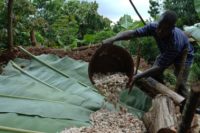Experts from leading cocoa and chocolate processing companies provide their take on what’s happened to cocoa butter/cocoa powder pricing — a relationship that traditionally had cocoa butter prices higher than cocoa powder.
Hugo van der Goes
Vice President Commercial
Cargill Cocoa & Chocolate
There are a few things to consider when looking at the relationship between cocoa powder and cocoa butter prices. First, it’s critical to keep in mind that when cocoa liquor is pressed, powder and butter are always created. Second, cocoa butter has basically one main application — chocolate products. Therefore, demand for cocoa butter can be analyzed by looking at worldwide chocolate consumption. On the other hand, cocoa powder is used in a large variety of different products including bakery, dairy and confectionary applications.
Over the last ten years, and most definitely the last five, there has not been a traditional price pattern. The market has become increasingly complex; more and more applications for powder are being introduced, and there are more regions in the world consuming both chocolate and powder-based food products. Cargill Cocoa & Chocolate believes that the balance between the two products will stay more dynamic.
This implies that the cocoa buyer needs to be closer to the market than ever before. As emerging countries continue to develop, and types of applications fluctuate, changes in supply and demand between powder and butter might occur more often. The relative growth difference between powder-based food applications and chocolate consumption will be one of the key factors to watch.
In the medium term, uncertainty about butter supply and demand may cause considerable fluctuations in the butter-powder price relationship. The balance between cocoa butter and powder has traditionally been one of the main price movement drivers, but the consumption of powder has emerged as another very important driver of forward prices.
Jeff Rasinski
Director of Commodities and Corporate Procurement
Blommer Chocolate Co.
The relationship between cocoa butter/cocoa powder ratios and or pricing is dynamic or constantly changing. The traditional or more historical norm is that cocoa butter trades at a premium relative to cocoa powder and this is, in fact, what we have seen unfold in 2012.
The high price of cocoa powder led to curtailed usage and surplus supply that dampened prices and compressed processing margins of cocoa processors who converted cocoa beans into its two related processed products: butter and powder.
As processing capacity was idled, concerns started to mount about supply and availability of cocoa butter across the industry. This, in turn, lead to a rapidly rising butter ratio and restoration of some of the margins to processed cocoa. So, yes, we would see the relationship between cocoa butter and cocoa powder returned to its more traditional formula and norm.
In fact, it already has. Impact of pricing is pretty simple and straight forward, cocoa butter has nearly doubled in price in the past nine months and powder has sunk by 35-40%. The availability question is harder to quantify.
There continues to be an expansion of capacity at origin, specifically West Africa and Asia (Indonesia), but with cocoa reform measures underway in Ivory Coast, and elimination of tax incentives for many origin processors, we see the supply of products from Ivory Coast in particular in question. Supply of products should continue to grow across Asia.
John Zima
Director of Sales
ADM Cocoa
Yes, we believe it will return to its traditional formula, and then it will change! The cocoa market is dynamic and influenced by many factors including supply and demand, weather, political activities and macroeconomic events. Changes in any of these factors will have an impact on pricing and supply until the market adjusts accordingly.





